|
|
Newsletter November 2021 | Menu of Newsletters

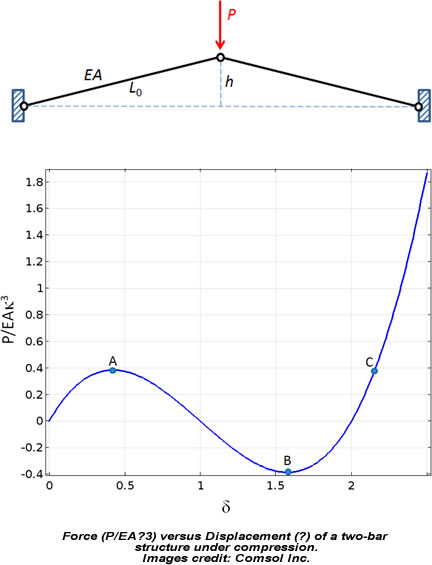
Notice that between points A and B,
displacement is increasing while force is decreasing. Thus, the
structure’s stiffness is negative in that region.
Negative-stiffness vibration isolators
consist of a horizontal isolator and a vertical isolator connected in series.
To counter motions that involve rotation (pitch and roll), a tilt motion pad
can also be connected in series with the horizontal and vertical isolators.
The horizontal isolator consists of two fixed-free vertical beams
(columns) supporting a weight. The weight imparts both eccentric (off-axis)
axial compressive load and a transverse bending load. This phenomenon is
referred to as the beam-column effect and causes the lateral bending stiffness
of the beams to decrease. In effect, the isolator is acting as a horizontal
spring with a negative-stiffness mechanism.
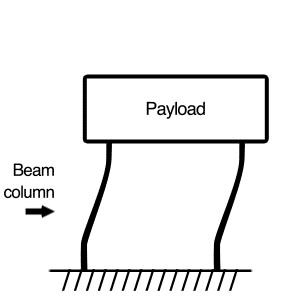
The horizontal isolator is designed to
take advantage of the beam-column effect, allowing it to act like a
negative-stiffness mechanism.
Vertical motion is addressed using two
horizontal flexures loaded in compression, which form a negative-stiffness
mechanism. The flexures are supported at their outer ends and connected to a
stiff spring at their inner ends. The stiffness of the isolator is determined
by the design of the flexures and by their compressive load.
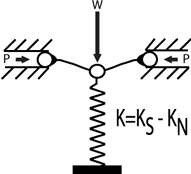
Two flexures, fixed at their outer ends
and connected to a spring at their inner ends, form a negative-stiffness
mechanism that isolates equipment from vertical motion due to
vibrations.
Full article...
|
|
Featured Product: WS-4 Compact Vibration Isolation
Table
- Vertical natural frequency of 1/2 Hz or less can be achieved over
the entire load range.
- Horizontal natural frequency is load dependent. 1/2 Hz or less can
be achieved at or near the nominal load.
- Horizontal natural frequency is load dependent. 1/2 Hz or less can
be achieved at or near the nominal load.
- Dimensions: 24" W x 24" D x 23" H
(610mm W x 610mm D x 533mm
H)
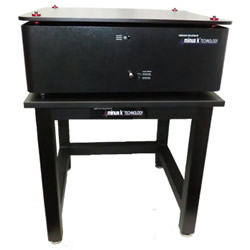 A cost
effective vibration isolation table for weight loads up to 1000 lb. and 1/2 Hz
performance vertical and horizontal. A cost
effective vibration isolation table for weight loads up to 1000 lb. and 1/2 Hz
performance vertical and horizontal.
The stand has been designed with a
damped Phenolic top which includes locating holes for the leveling feet of the
BM-1 and
BM-4.
Pricing & Specifications
|


Close-up of a stylus and LP record
vinyl grooves
"Vinyl remains unsurpassed for
reproducing music,” said Mark Döhmann, Founder of Döhmann Audio.
To convey vinyls rich, nuanced potential a turntable must have precise speed
control and operate without producing mechanical or electronic noise. The goal
is an uncompromised signal emerging from a silent background, resulting from
precisely designed construction that eliminates noise and gives precision speed
control for ideal playback.
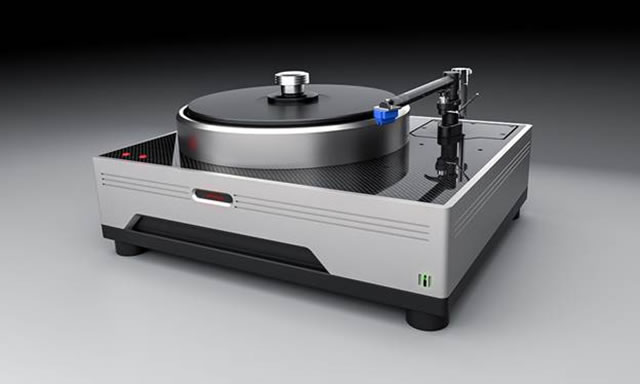
This goal has been very closely
approximated with the release of the Helix One and Helix Two turntables,
representing a breakthrough in analog playback design and execution. These
turntables are a showcase for micro-signal architecture, a new way of thinking
borne from the world of ultra-precision sub-atomic research, where the removal
of unwanted vibration is critical to achieving precision results.
The
Helix One and Helix Two turntables reward the listener with the closest
facsimile to master tape yet realized. Their specifications demand the ultimate
in noise suppression and vibration isolation systems, allowing the turntables
and pick-up arms to deliver the micro-signals buried in the vinyl grooves of
LPs.
Every aspect of the turntables' design requires the preservation
of the micro-signals found in the grooves of the LP to be retrieved with as
little modification and distortion as physically and electronically possible,
added Döhmann. The turntables incorporate a number of engineering advances
to deliver the lowest resonance profile for any pickup arm and LP
combination.
These engineering advances include: a) mechanical crossover
technology; b) a tri-modal platter system; c) an edge-damping ring; d) a tone
arm damping system; e) resonance-tuned suspension; f) a diamond-like coating,
amorphous material-bearing friction modifier; g) high-torque, adjustable-drive
speed selections; and h) a velocity adjustment lock.
But what
contributes to making the Helix One and Helix Two turntables truly unique is
their highly precise, fully-integrated vibration isolation system.
The Need For Vibration
Isolation
Vibration isolation in the playback process of high-end audio
systems is crucial. Any external vibration, no matter how slight, even someone
walking near the turntable or vibration from floor-mounted speakers, is sensed
by the turntables stylus and affects the sound being played back from the
record. Capacitors, resistors, transistors, tube amplifiers and other
electronic components are likewise sensitive to vibration.
Analog audio
is a very detailed and information rich storage and retrieval mechanism,
continued Döhmann. The enemy of retrieval information is vibration, which
can modulate with the needle as it works its way through the groove. If you can
remove exterior vibration and allow the needle to operate in an optimally quiet
method or platform, then you will get more information out because your noise
is much lower.
Full article...
More at our Audio & Turntable Vibration Isolation
Applications page...
|


(2016 Legacy Article) The tunable
microwave-frequency alternating current scanning tunneling microscope (ACSTM)
has opened the possibility of recording local spectra and local chemical
information on insulator surfaces, much like the conventional scanning
tunneling microscope (STM) has done for metals and
semiconductors..
Spectroscopy in the microwave frequency range enables
unrealizable measurements on conducting substrates, such as the rotational
spectroscopy of a single adsorbed molecule. Developed in the early 1990s by
Professor Paul Weiss, the nano-pioneering Director of the Weiss Group, a
nanotechnology research unit of UCLAs California NanoSystems Institute, the
ACSTMs single-molecule measurement techniques have illuminated unprecedented
details of chemical behavior, including observations of the motion of a single
molecule on a surface, and even the vibration of a single bond within a
molecule. Such measurements are critical to understanding entities ranging from
single atoms to the most complex protein assemblies.We use molecular design,
tailored syntheses, intermolecular interactions and selective chemistry to
direct molecules into desired positions to create nanostructures, to connect
functional molecules to the outside world, and to serve as test structures for
measuring single or bundled molecules, said David McMillan, Lead Technician at
the Weiss Group.
Critical to understanding these variations has been
developing the means to make tens- to hundreds-of-thousands of independent
single-molecule measurements in order to develop sufficiently significant
statistical distributions, while retaining the heterogeneity inherent in the
measurements.
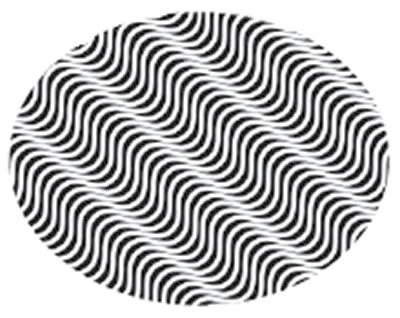
Vibration isolation
To achieve
these nano-level chemical and spectroscopic data sets, the ACSTM must be
positioned in an ultra-stable operating environment, one free of low-frequency
vibrations.The lab was using almost exclusively optical tables on pneumatic
isolation, said McMillan.One of our big problems has been space constraint. We
needed smaller pneumatic optical tables to fit. But as the air tables get
smaller, their vibration isolation performance diminishes.
Full article... |

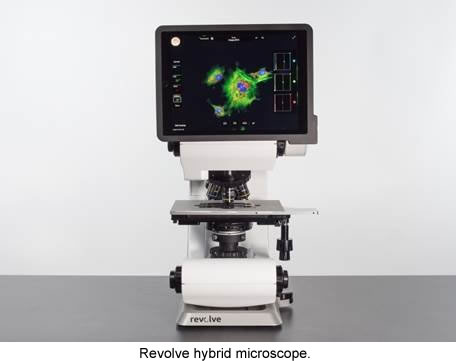
The compound microscope has evolved from an
instrument providing simple contrast viewing, into super-resolution systems
capable of sub-diffraction accuracy. Its two platforms, upright and inverted,
can be found in most laboratories doing cellular research, such as in biotech
and pharmaceutical. Upright microscopes are used for viewing glass slides, and
inverted for viewing live cells in Petri dishes. Despite its imaging advances,
the basic architecture of the compound microscope has not substantially been
modified in centuries.
This has now changed, with the recent release of
the Revolve hybrid compound microscope, developed by Echo Laboratories (Echo),
which has set a new precedent in microscope usability and design. The Revolve
combines the full functionality of both upright and inverted microscopes in one
instrument, and can switch between the two imaging modes relatively swiftly and
easily. This gives the flexibility to view many types of samples with one
microscope to a level of 300 350 nanometers resolution.
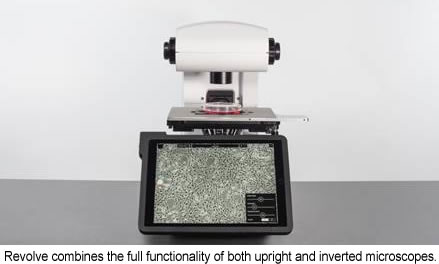
“More than 70 percent of labs end up
having both inverted and upright microscopes,” said Jeff Huber, Director
of Sales for Echo Laboratories. “But both uprights and inverts use similar
objectives, illuminators, position systems and cameras. Why duplicate all of
these expensive components? And why take up valuable lab space with two
instruments? So, Echo Laboratories engineered a way to merge these two systems
into one unified instrument, which is the Revolve
microscope.”
Brightfield, Phase Contrast and Epifluorescence
Imaging with iPad and Wireless Upload
his is a compound, infinity-path
microscope, with applications for brightfield, phase contrast, and
epi-fluorescence imaging. Current glass selection includes the entire line of
Olympus objectives. Due to the unique nature of the upright/inverted
combination, both a high-NA and long-working-distance transmitted-light
condensers are available to support phase and brightfield. A high-accuracy
locking mechanism is used to securely hold the condenser assembly in place,
while still allowing for easy removal by a single lever.
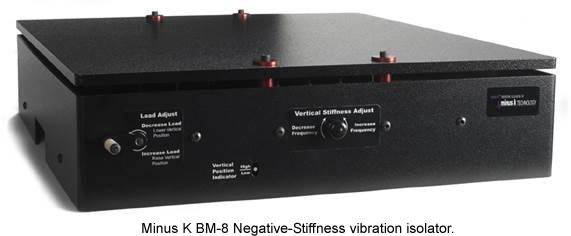
Full article... |

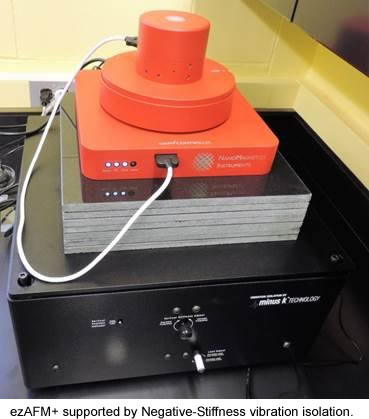
Since the release of the first commercial
atomic force microscope (AFM) about 30 years ago, technology advances have
steadily been implemented to improve their performance. Now, the most recent
advance in ambient-temperature AFMs is making them more compact, portable and
user-friendly, which is enabled by Negative-Stiffness vibration isolation.
The atomic force microscope (AFM) has become one of the foremost tools
for imaging and measuring materials and cells on the nanoscale. Revealing
sample details at the atomic level, with resolution on the order of fractions
of a nanometer, the AFM is instrumental for imaging an array of applications,
such as defining surface characterizations, lithography, data storage, and
manipulation of atoms and nano-sized structures on a variety of
surfaces.
The AFM utilizes a sharp tip (probe) with a radius of
curvature on the order of a few nanometers attached to the end of a tiny
cantilever used to scan across a sample surface to image its topography and
material properties. When the tip is brought into proximity of a sample
surface, forces between the tip and the surface lead to a deflection of the
cantilever. This deflection is recorded using, typically, a laser beam that is
reflected from the top surface of the cantilever to a photo-sensitive detector.
The resultant change of position of the cantilever/probe/tip permits
characteristics such as mechanical, electrostatic, magnetic, chemical and other
forces to be precisely measured by the AFM. These characteristics are displayed
in a three-dimensional surface profile of the sample (in the X, Y and Z axes),
an advantage that the AFM can provide compared to other microscopy
techniques.
Although AFM technology has advanced considerably, its
benefits have not always been easily accessible for researchers requiring AFM
adaptability, portability. Nor have AFMs been adequately accessible in
nanotechnology student laboratories, because of lack of student skill in their
operation, and budget limitations on the number of AFMs at their
disposal.
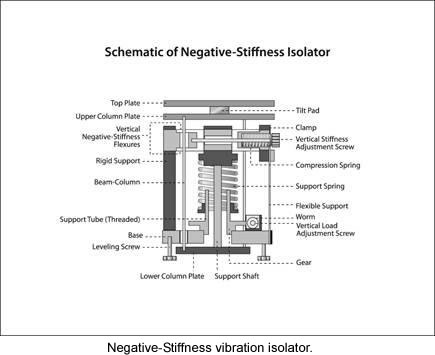
A More Portable, More User-Friendly
AFM
These inhibitions have now been mitigated by a relatively new
compact, portable and user-friendly ambient-temperature AFM. Developed by
NanoMagnetics Instruments, a leading manufacturer of scanning probe microscopes
for low-temperature applications, the ezAFM+ atomic force microscope is a
benchtop instrument designed for short learning times, quick setup, and ease of
transport.
Full article... |
|
|
|

 |
|
|
